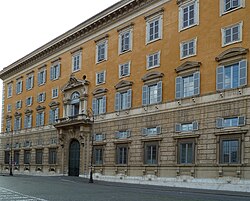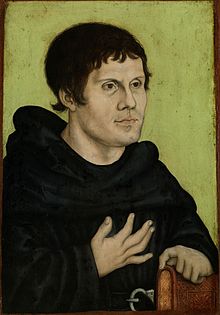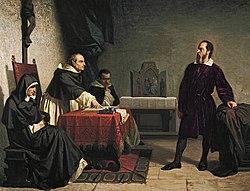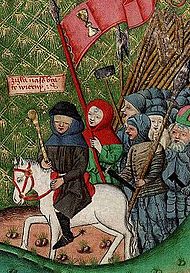| Latin: Congregatio pro Doctrina Fidei | |

Coat of arms of the Holy See
| |
| Congregation overview | |
|---|---|
| Formed | 1542 |
| Preceding agencies |
|
| Type | Congregation |
| Headquarters | Palace of the Holy Office Rome, Italy |
| Congregation executive |
|
The Congregation for the Doctrine of the Faith (CDF; Latin: Congregatio pro Doctrina Fidei) is the oldest among the nine congregations of the Roman Curia, seated at the Palace of the Holy Office in Rome. It was founded to defend the church from heresy; today, it is the body responsible for promulgating and defending Catholic doctrine. Formerly known as the Supreme Sacred Congregation of the Roman and Universal Inquisition, it is informally known in many Catholic countries as the Holy Office (Latin: Sanctum Officium), and between 1908 and 1965 was officially known as the Supreme Sacred Congregation of the Holy Office.
Founded by Pope Paul III in 1542, the congregation's sole objective is to "spread sound Catholic doctrine and defend those points of Christian tradition which seem in danger because of new and unacceptable doctrines." Its headquarters are at the Palace of the Holy Office, just outside Vatican City. The congregation employs an advisory board including cardinals, bishops, priests, lay theologians, and canon lawyers. The current Prefect is Cardinal Luis Ladaria Ferrer, who was appointed by Pope Francis for a five-year term beginning July 2017.
Pope Francis has planned a reorganization of the Curia that will alter the role of this Congregation. A final draft of his apostolic constitution on the Roman Curia, titled Praedicate Evangelium (“Preach the Gospel”), has been submitted for comment to national bishops’ conferences and a variety of other bodies. However, it has also been agreed that changes to the Congregation will only reform Catholic missions and not affect Catholic doctrine.
History
Astronomer Galileo Galilei presented before the Holy Office, a 19th-century painting by Joseph-Nicolas Robert-Fleury
On 21 July 1542, Pope Paul III proclaimed the Apostolic Constitution Licet ab initio, establishing the Supreme Sacred Congregation of the Roman and Universal Inquisition, staffed by cardinals and other officials whose task it was "to maintain and defend the integrity of the faith and to examine and proscribe errors and false doctrines." It served as the final court of appeal in trials of heresy and served as an important part of the Counter-Reformation.
This body was renamed the Supreme Sacred Congregation of the Holy Office in 1908 by Pope Pius X. In many Catholic countries, the body is often informally called the Holy Office (e.g., Italian: Sant'Uffizio and Spanish: Santo Oficio).
The congregation's name was changed to Sacred Congregation for
the Doctrine of the Faith (SCDF) on 7 December 1965, at the end of the Second Vatican Council. Soon after the 1983 Code of Canon Law came into effect, the adjective "sacred" was dropped from the names of all Curial Congregations, and so the dicastery adopted its current name, the Congregation for the Doctrine of the Faith.
Timeline
| 1542 | Supreme Sacred Congregation of the Roman and Universal Inquisition is established "to maintain and defend the integrity of the faith and to examine and proscribe errors and false doctrines." |
| 1622 | Pope Gregory XV writes a letter addressing the issue of priests abusing the confessional to solicit "shameful and dishonorable conduct". The letter is referenced in Sacramentum Poenitentiae (1741). |
| 1665 | The General Congregation of the Universal Inquisition, in the presence of Pope Alexander VII, reiterates that propositions by confessors to solicit or provoke sex from penitents are "alien and discordant by the Evangelical truth and clearly so by the sixth and seventh doctrines of the Holy Fathers" and are to be "checked, condemned, and prohibited. […] The Inquisitors of Heretical Depravity […] [should] seek out and proceed against everyone – every priest […] who has essayed to tempt a penitent." |
| 1908 | The Inquisition is renamed Supreme Sacred Congregation of the Holy Office by Pope Pius X. |
| 1965 | The Supreme Sacred Congregation of the Holy Office is renamed Sacred Congregation for the Doctrine of the Faith (SCDF). |
| 1985 | All dicasteries of the Roman Curia no longer use the adjective "sacred" as part of their title. The Sacred Congregation for the Doctrine of the Faith becomes the Congregation for the Doctrine of the Faith (CDF). |
| 1988 | Pope John Paul II reaffirms the authority of the CDF on 28 June: "The proper duty of the Congregation for the Doctrine of the Faith is to promote and safeguard the doctrine on faith and morals in the whole Catholic world; so it has competence in things that touch this matter in any way." |
| 2001 | John Paul II issues Sacramentorum sanctitatis tutela "by which are promulgated Norms concerning the more grave delicts reserved to the Congregation for the Doctrine of the Faith." It, again, reaffirms the CDF's responsibilities, expressing that it was necessary to define more precisely both "the more grave delicts whether against morals or committed in the celebration of the sacraments" for which the competence of the Congregation for the Doctrine of the Faith remains exclusive, and also the special procedural norms "for declaring or imposing canonical sanctions." |
| 2014 | On 11 November Pope Francis sets up within the CDF a special body to expedite consideration of appeals by priests against laicization or other penalties imposed on them in cases of sexual abuse. |
| 2015 | Francis establishes an ecclesiastical judicial commission, which will have its own staff and secretary, to try bishops, which will work with other units of the CDF and with the congregation that has oversight over the bishop. |
| 2018 | Francis appoints three women as consultors to the Congregation, the first in its history. |
| 2019 | The Pontifical Commission Ecclesia Dei is merged into the Congregation. |
Role
According to the 1988 Apostolic Constitution on the Roman Curia, Pastor bonus,
article 48, promulgated by John Paul II: "The proper duty of the
Congregation for the Doctrine of the Faith is to promote and safeguard
the doctrine on faith and morals in the whole Catholic world; so it has
competence in things that touch this matter in any way."
The Palace of the Holy Office, seat of the Congregation for the Doctrine of the Faith.
This
includes investigations into grave delicts, i.e., acts which the
Catholic Church considers as being the most serious crimes: crimes
against the Eucharist
and against the sanctity of the Sacrament of Penance, and crimes
against the sixth Commandment ("Thou shall not commit adultery.")
committed by a cleric against a person under the age of eighteen. These
crimes, in Sacramentorum sanctitatis tutela a motu proprio
of 2001, come under the competency of the Congregation for the Doctrine
of the Faith. In effect, it is the "promoter of justice" which deals
with, among other things, the question of priests accused of paedophilia.
Within the CDF are the International Theological Commission, the Pontifical Biblical Commission, and the Pontifical Commission Ecclesia Dei. The Prefect of the CDF is ex officio president of these commissions.
Organization
Until 1968, the pope held the title of prefect and appointed a cardinal to preside over the meetings, first as Secretary, then as Pro-Prefect.
Since 1968, the Cardinal head of the dicastery has borne the title of Prefect and the title of Secretary
refers to the second highest-ranking officer of the Congregation. As of
2012 the Congregation had a membership of 18 cardinals and a smaller
number of non-cardinal bishops, a staff of 38 (clerical and lay) and 26
consultors.
The work of the CDF is divided into four sections: the doctrinal,
disciplinary, matrimonial, and clerical offices. The CDF holds biennial
plenary assemblies, and issues documents on doctrinal, disciplinary,
and sacramental questions that occasionally include notifications
concerning books by Catholic theologians (e.g., Hans Küng, Charles Curran, and Leonardo Boff) that it judges contrary to Church doctrine.
Recent canonical judgments and publications
The following is a list of recent documents and judgments issued by
the CDF. Lengthy CDF documents usually have Latin titles. A short
document that briefly states objections to one or more writings by a
Catholic theologian is typically called a "notification."
- "Doctrinal Assessment of the Leadership Conference of Women Religious" – (Re-affirmed by Pope Francis on 15 April 2013)
- "Note on the banalization of sexuality, Regarding certain interpretations of Light of the World" (22 December 2010)
- "Circular Letter to the Presidents of the Episcopal Conferences regarding the association Opus Angelorum" (2 October 2010)
- Dignitas Personae (on bioethical questions, with summary and press conference transcript; 8 September 2008)
- On 5 April 2008, as a result of "grave reservations" by the Congregation for the Doctrine of the Faith about the Mormon practice of posthumous rebaptism, Catholic dioceses throughout the world were directed not to give information in parish registers to the Mormons' Genealogical Society of Utah for microfilming or digitizing.
- "Doctrinal Note on Some Aspects of Evangelization" (with press conference transcript; 3 December 2007)
- On 28 September 2007, Gaston Hebert, the then apostolic administrator of the Diocese of Little Rock, stated that (per the 11 July Congregation for the Doctrine of the Faith) six Arkansas nuns were excommunicated for heresy (the first in the diocese's 165-year history). They refused to recant the doctrines of the Community of the Lady of All Nations (Army of Mary). The nuns are members of the Good Shepherd Monastery of Our Lady of Charity and Refuge in Hot Springs. Sister Mary Theresa Dionne, 82, one of the six, said they will still live at the convent property, which they own. The sect believes that its 86-year-old founder, Marie Paule Giguere, is the reincarnation of the Virgin Mary.
- "Responses to Certain Questions of the United States Conference of Catholic Bishops Concerning Artificial Nutrition and Hydration" (with commentary; 1 August 2007)
- "Responses to Some Questions Regarding Certain Aspects of the Doctrine on the Church" (29 June 2007)
- In an April 2007 address to chaplains, Archbishop Amato denounced same-sex marriage and abortion and criticized the Italian media's coverage of them, saying that they are evils "that remain almost invisible" due to media presentation of them as "expression of human progress."
- "Notification on the works of the Reverend Father Jon Sobrino, SJ" (with an explanatory note; 26 November 2006)
- "Notification regarding the book Jesus Symbol of God of the Reverend Father Roger Haight, SJ"
- "Letter to the Bishops of the Catholic Church on the collaboration of men and women in the Church and in the world" (31 May 2004)
- "Doctrinal Note on some questions regarding the participation of Catholics in political life" (with two commentaries from Cardinals Joachim Meisner and Giacomo Biffi; 24 November 2002),
- "Considerations Regarding Proposals to Give Legal Recognition to Unions Between Homosexual Persons" (3 June 2003)
- "Note on the Force of the Doctrinal Decrees Concerning the Thought and Work of the Reverend Father Antonio Rosmini Serbati" (1 July 2001)
- "Notification regarding certain writings of the Reverend Father Marciano Vidal, CSSR" (with comments; 22 February 2001)
- "Notification on the book Toward a Christian Theology of Religious Pluralism by the Reverend Father Jacques Dupuis, SJ" (with commentary; 24 January 2001)
- "Notification concerning some writings of Professor Dr. Reinhard Messner" (30 November 2000)
- Ardens felicitatis (instructions on prayers for healing; 14 September 2000)
- Dominus Iesus (Declaration on the unicity and salvific universality of Jesus Christ and the Church; with comments from Congregation officials; 6 August 2000)
- "Note on the expression 'sister churches'" (30 June 2000)
- "Documents regarding 'The Message of Fatima'" (26 June 2000)
- "Notification regarding Sister Jeannine Gramick, SSND, and the Reverend Father Robert Nugent, SDS"
- "Considerations on The Primacy of the Successor of Peter in the mystery of the Church" (31 October 1998)
- "Formula to be used for the profession of faith and for the oath of fidelity to assume an office to be exercised in the name of the Church" (with an "Illustrative doctrinal note" by Cardinal Ratzinger and Archbishop Bertone) (29 June 1998)
- "Notification concerning the writings of the Reverend Father Anthony De Mello, SJ" (24 June 1998)
- "Notification concerning the text Mary and Human Liberation by the Reverend Father Tissa Balasuriya, OMI" (2 January 1997)
- "Notification on the writings and activities of Mrs. Vassula Ryden" (6 October 1995)
- "Responses to questions proposed concerning uterine isolation and related matters" (31 July 1993)
- "Some considerations concerning the response to legislative proposals on the non-discrimination of homosexual persons" (23 July 1992)
- "Decree on the doctrine and customs of the Association Opus Angelorum" (6 June 1992)
- Communionis notio (Letter to the Bishops of the Catholic Church on some aspects of the Church understood as Communion; 28 May 1992)
- "Instruction on some aspects of the use of the instruments of social communication in promoting the doctrine of the faith" (30 March 1992)
- "Note on the book The Sexual Creators, An Ethical proposal for Concerned Christians, (University Press of America, Lanham, New York, London 1986), by the Reverend Father André Guindon, OMI" (31 January 1992)
- Donum veritatis (Instruction on the ecclesial vocation of the theologian; 24 May 1990)
- Orationis formas (Letter to the Bishops of the Catholic Church on some aspects of Christian meditation; 15 October 1989)
- "Note regarding the moral rule of Humanae vitae (Pope Paul VI's encyclical, On the Regulation and Control of Human Birth) and the pastoral duty" (16 February 1989)
- "Observation of the Anglican-Roman Catholic International Commission (ARCIC) II's Salvation and the Church" (18 November 1988)
- "Formula to be used for the profession of faith and for the oath of fidelity to assume an office to be exercised in the name of the Church" (1 July 1988)
- Donum vitae (Instruction on respect for life in its origin and on the dignity of procreation; 22 February 1987)
- Homosexualitatis problema (Letter to the Bishops of the Catholic Church on the Pastoral Care of Homosexual Persons; 1 October 1986)
- "Notification on the book Pleidooi voor mensen in de Kerk (Nelissen, Baarn 1985) by the Reverend Father Professor Edward Schillebeeckx, OP" (15 September 1986)
- "Letter to György Bulányi on certain writings attributed to him" (1 September 1986)
- "Letter regarding the suspension of the Reverend Father Professor Charles Curran from the teaching of theology" (25 July 1986)
- Libertatis conscientia (Instruction on human freedom and liberation; 22 March 1986)
- "Notification on the book Church: Charism and Power: Essay on Militant Ecclesiology by Leonardo Boff, OFM" (11 March 1985)
- Recentiores episcoporum synodi (on some questions of Eschatology) (17 May 1979)
- Inter insigniores (Declaration as to the question of admitting women to priesthood) (15 October 1975)
Leadership
Secretaries until 1965
When
the Supreme Sacred Congregation for the Roman and Universal Inquisition
was first established in 1542, it was composed of several Cardinal
Inquisitors styled as "Inquisitors-General", who were formally equal to
each other, even if some of them were clearly dominant (e.g. Cardinal
Gian Pietro Carafa from 1542, who was elected Pope Paul IV in 1555).
Until 1968 the Pope himself presided over the Congregation. However,
from 1564 the daily administration of the affairs of the Congregation
was entrusted to the Cardinal Secretary.
This model was retained when the Inquisition was formally renamed as
the Supreme Sacred Congregation of the Holy Office in 1908.
Unless stated otherwise, the secretaryship ended with the officeholder's death.
- Antonio Michele Ghislieri (1564–1566; elected as Pope Pius V)
- Giacomo Savelli (1577–1587)
- Giulio Antonio Santori (1587–1602)
- Camillo Borghese (1602–1605; elected as Pope Paul V)
- Pompeio Arrigoni (1605–1612; resigned, died in 1616)
- Giovanni Garzia Millini (1612–1629)
- Antonio Marcello Barberini (1629–1633; resigned; died in 1646)
- Francesco Barberini (1633–1679)
- Cesare Facchinetti (1680–1683)
- Alderano Cybo (1683–1700)
- Galeazzo Marescotti (1700–1716; resigned, died in 1726)
- Fabrizio Spada (1716–1717)
- Nicolò Acciaioli (1717–1719)
- Francesco del Giudice (1719–1725)
- Fabrizio Paolucci (1725–1726)
- Pietro Ottoboni (1726–1740)
- Tommaso Ruffo (1740–1753)
- Neri Maria Corsini (1753–1770)
- Giovanni Francesco Stoppani (1770–1774)
- Luigi Maria Torregiani (1775–1777)
- Carlo Rezzonico (1777–1799)
- Leonardo Antonelli (1800–1811)
- Giulio Maria della Somaglia (1814–1830)
- Bartolomeo Pacca (1830–1844)
- Vincenzo Macchi (1844–1860)
- Costantino Patrizi Naro (1860–1876)
- Prospero Caterini (1876–1881)
- Antonio Maria Panebianco (1882–1883)
- Luigi Bilio, CRSP (1883–1884)
- Raffaele Monaco La Valletta (1884–1896)
- Lucido Parocchi (1896–1903)
- Serafino Vannutelli (1903–1908) (resigned)
- Mariano Rampolla (1908–1913)
- Domenico Ferrata (3 January 1914 – 10 October 1914)
- Rafael Merry del Val (14 October 1914 – 26 February 1930)
- Donato Sbarretti (4 July 1930 – 1 April 1939)
- Francesco Marchetti-Selvaggiani (30 April 1939 – 13 January 1951)
- Giuseppe Pizzardo (16 February 1951 – 12 October 1959)
- Alfredo Ottaviani (7 November 1959 – 7 December 1965, when he was made Pro-Prefect)
Prefects since 1965
When
Pope Paul VI changed the name of the dicastery on 7 December 1965, he
changed the title of the cardinal in charge of the daily administration
of the Congregation from Secretary to Pro-Prefect. He continued to
reserve the title of Prefect to himself until 1968 when he relinquished his role as head of the Congregation and named a Prefect.
- Alfredo Ottaviani (7 December 1965 – 6 January 1968, his retirement) Titled: Pro-Prefect
- Franjo Šeper (8 January 1968 – 25 November 1981, his retirement)
- Joseph Ratzinger (25 November 1981 – 2 April 2005, death of Pope John Paul II)
- William Levada (13 May 2005 – 2 July 2012, his retirement)
- Gerhard Ludwig Müller (2 July 2012 – 2 July 2017, appointment not renewed)
- Luis Ladaria Ferrer, SJ (2 July 2017 – present)
Secretaries since 1965
With
the December 1965 reorganization of the Holy Office as the Sacred
Congregation for the Doctrine of the Faith, the head of the Congregation
was no longer titled Secretary. The dicastery's second-in-command,
until then titled assessor, was then given the title of Secretary, as
was already the case with the other Roman Congregations. The following
Archbishops have held the title of Secretary:
- Pietro Parente (7 December 1965 – 1967)
- Paul-Pierre Philippe, O.P. (29 June 1967 – 6 March 1973)
- Jean Jérôme Hamer, O.P. (14 June 1973 – 8 April 1984)
- Alberto Bovone (5 April 1984 – 13 June 1995)
- Tarcisio Bertone, S.D.B. (13 June 1995 – 10 December 2002)
- Angelo Amato, S.D.B. (19 December 2002 – 9 July 2008)
- Luis Ladaria Ferrer, S.J. (9 July 2008 – 2 July 2017)
- Giacomo Morandi (18 July 2017 – present )
Present composition
- Prefect: Cardinal Luis Ladaria Ferrer, S.J.
- Secretary: Archbishop Giacomo Morandi
- Adjunct Secretary: Archbishop Joseph Augustine Di Noia, O.P.
- Adjunct Secretary: Archbishop Charles Scicluna
- Official: Archbishop José Luis Mollaghan
- Undersecretary: Fr. Matteo Visioli
- Promoter of Justice: Fr. Robert J. Geisinger S.J.
- 27 members
- 28 Consultors (religious superiors and canon lawyers)
- Staff of 33 lay theologians












